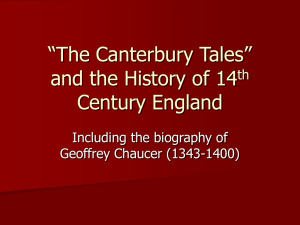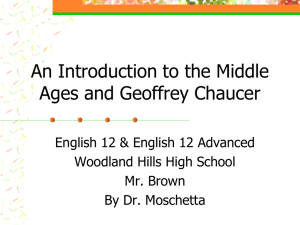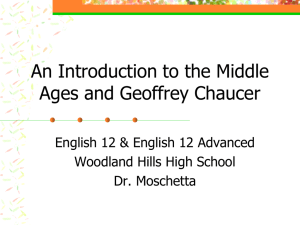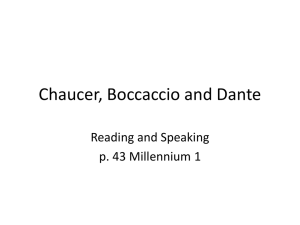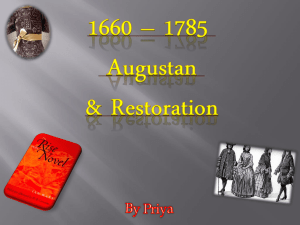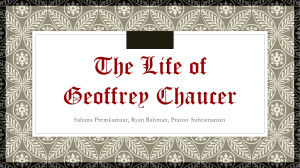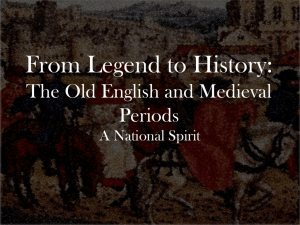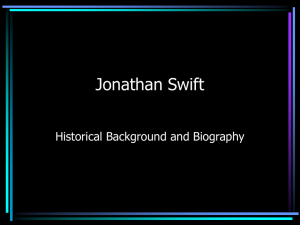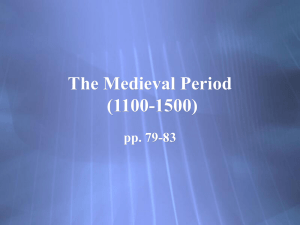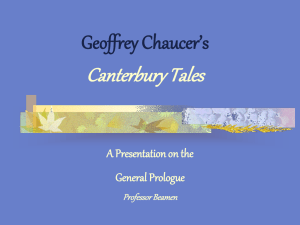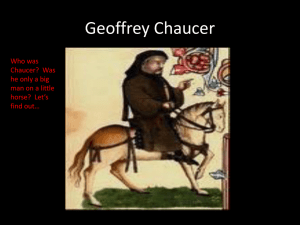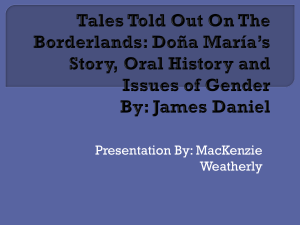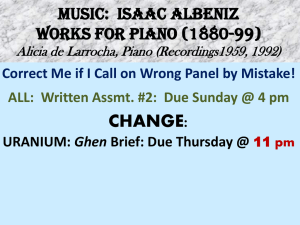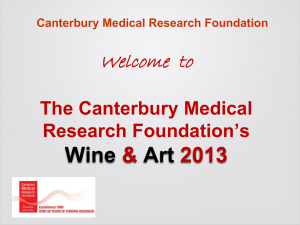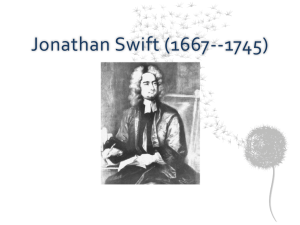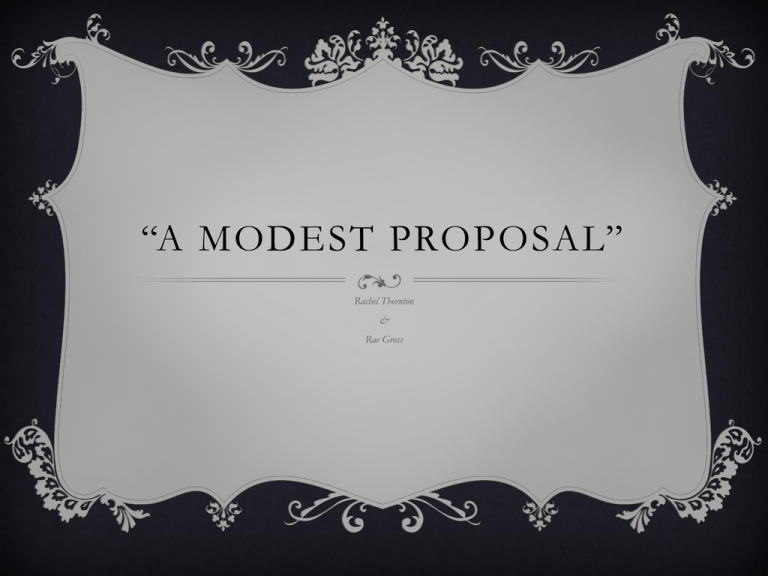
“A MODEST PROPOSAL”
Rachel Thornton
&
Rae Gross
SUMMARIZE:
Swift is criticizing the wealthy British people because they will not help the poor
Irish people even though they have the money to do so.
Page 615 says, “…Therefore, whoever could find out a cheap, and easy method
of making these children sound useful members of the common wealth would
deserve so well of the public as to have his statue set up for a preserver of the
nation.”
This passage from “A Modest Proposal” is saying that if the wealthy are going to
judge the poor, they might as well find a good use for them. It is also saying that if
they could find a good use for them in a cheap and easy way, that they would deserve
praise because they would be a “preserver of the nation”.
IDENTIFY:
The intended audience for “A Modest Proposal” is the wealthy British
people, and he wants them to help the poor Irish people. Swift basically wanted
to shock the wealthy into helping the poor. He did this by stating that if the
wealthy were not going to help the poor, they might as well just eat the children
so they could have food.
On page 614 it says, “…best audience for “A Modest Proposal” was the
upper class – a group of people who had the ability to make changes for the
better…”
IDENTIFY:
The Irish were so poor in the 1700’s because of a famine that they
were experiencing. They had to move from their home in Ireland to places
such as Canada, America, and the UK to try to better their lives. They
were extremely poor to start with, and when they moved it was no
different. They were discriminated against, they were poor, and they had
nothing that they could do about that. That is why Swift wanted to shock
the wealthy into helping the poor Irish people, because there was no other
way to help them.
COMPARE & CONTRAST:
This view of society to Chaucer’s view of society;
• Swift believed that the wealthy people were bad because they would not listen to him when he
asked for their assistance in helping the poor, when they could obviously help tremendously.
• Chaucer believed that there were a lot of bad people in society, and he openly criticized them
in “The Canterbury Tales”. He criticized a wide variety of people, from church people to
common people. He described people from the Friar, who was a greedy and sinful priest, to
the Wife of Bath, who was a woman who married 5 different men. These two people are very
different, so that shows how Chaucer criticizes all types of people.
How are they similar? They both criticized the upper class/wealthy people in their societies,
and how they did not care for the poor.
How are they different? Chaucer did not go nearly as far as Swift did when criticizing people.
Chaucer simply pointed out that everyone had flaws, while Swift suggested that people should eat
children, just to get the wealthy people’s attention.
COMPARE & CONTRAST:
These societies to American society:
• Swift & Chaucer’s societies: Both of these societies were corrupt in their own ways.
“The Canterbury Tales” showed many different types of flaws within many different
types of people (such as the friar, the wife of Bath, etc.). “A Modern Proposal” mainly
focused on the flaws of the wealthy such as their greed and self-centeredness. So, both
were corrupt.
• American society is definitely corrupt. There is a lot of crime, war, and poverty going on
in today’s society. In complete honesty, our society is just messed up, much like
Chaucer’s society and Swift’s society. Every society has it’s flaws, and not only do
Chaucer and Swift show that, but our own society shows that as well.
How are they similar? They are both corrupt and flawed.
How are they different? The types of crimes and wars going on are not quite the
same. For example, I highly doubt that people go around today swindling money from
people because of pardons like the pardoner did.
COMPARE & CONTRAST
(WHAT WE THINK):
We side with Chaucer more, simply because he does not only point
out the flaws of one social group. Swift only shows the flaws of the
wealthy, and we do not believe that all wealthy people are selfish.
Chaucer showed more variety in who he criticized, and we believe that
this applies more to today’s society because more than one social class
is flawed.
EVALUATE:
1300’s society in “The Canterbury Tales”:
“The Canterbury Tales” shows that the society of that time was extremely flawed.
Chaucer showed that everyone had flaws. He did this by describing many different
people within different social classes. He showed how much respect depended on their
social class. For instance, the Friar was a horrible man, he got girls pregnant and he was
greedy, yet he was respected just because he was a part of the church.
In “The Canterbury Tales” Chaucer writes, “He was an easy man in penance-giving,
Where he could hope to make a decent living.”
This means that the Friar charged money at the confessions, only because he knew
he would make a lot of money from it. This shows how greedy people can be.
EVALUATE:
1700’s society in “A Modest Proposal”:
Swift concentrated more on the fact that the wealthy were self-centered. He showed the flaws that
the wealthy had, making it seem like the poor people did not have flaws. He made the poor people
out to be the victims and the wealthy to be the villains, which, in a way, was correct. The poor had no
way to help themselves, and the rich had the means to help them, but they would not. He had to go
to great lengths to get their attention, which is another example of how self-centered the wealthy
people of that time were.
In “A Modest Proposal” Swift writes, “… crowded with beggars of the female sex, followed by
three, four, or six children, all in rags, and importuning every passenger for an alms.”
This was saying that the poor had to walk around the city and beg for money, yet the rich would
not spare any. The streets were crowded and all the poor, even children, had to beg for money.
EVALUATE:
Society in the 1300’s:
In the 1300’s it was early medieval times and English society began
to rapidly change.
Economic times became to get better along with health.
During this time wealthier people looked down upon the poor and
treated them very badly.
EVALUATE:
Society in the 1700’s:
In the 1700’s the women had hard jobs keeping up with the house hold
and it was very unappreciated.
Men and women had very high social pressure to get married. They
usually got married at 13 or 14 years of age.
Marriage was for economic benefit back in these times.
Also in this time period poor people were looked down upon by the
wealthy. It was a demeaning to the society.
EVALUATE:
We think that society had gotten (better or worse?)
We think the society hasn’t gotten better or worse between these
times and this is said because people during these times still treat the
poor just as bad.
PERSONALIZE:
You can easily find people like the wealthy people that were described in
Swift’s essay. There are many celebrities that get caught up in the fact that they
are rich and famous that they do not seem to care for others at all. For example,
Lindsey Lohan, Britney Spears, and Amy Winehouse are all examples of people
who got too caught up in their fame. They all ended up doing drugs and pretty
much ruining their lives (one quite literally) because they were too caught up in
their lifestyle. They did not care about what people would think of them or how
it would affect others, they did what they wanted to do and they had to pay the
consequences.
PERSONALIZE:
It is also quite easy to find people like the people that were described in “The
Canterbury Tales”, even more so than the people described in “A Modest
Proposal”. Almost anyone can fit into the criticism that Chaucer described. There
are money-hungry people everywhere like the Pardoner, there are hypocritical
people like the Friar, and there are people that get married a lot like the Wife of
Bath. One could just step out their front door and see someone like this easily.
WORK CITED
"The History of English: Early Modern English." Rice University.
Web. 25 Mar. 2012.
<http://www.ruf.rice.edu/~kemmer/Histengl/emode.html>.
“What Was the Social Structure in the 1300's - Medieval Europe?"
WikiAnswers. Answers. Web. 25 Mar. 2012.
<http://wiki.answers.com/Q/What_was_the_social_structure_in_th
e_1300's_-_medieval_Europe>.


